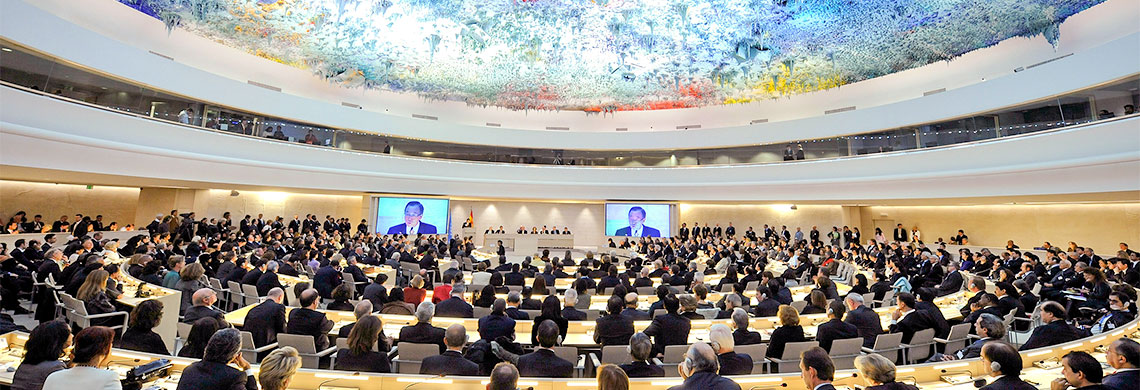Raphael Lemkin - Father of the Convention on the Prevention and Punishment of the Crime of Genocide
 They year 2011 marks the sixtieth anniversary of the entering into force of the Convention on the Prevention and Punishment on the Crime of Genocide. It might surprise some people that both the term genocide and the UN convention for its prevention and punishment can be largely attributed to the work of just one man. It is therefore worthwhile taking a moment to consider the incredible life of the man who was the convention's key architect, to reflect on the influence of the convention and the work that remains to be done. This analysis should be undertaken not only to honor Lemkin's memory, but also the victims of genocide across the world.
They year 2011 marks the sixtieth anniversary of the entering into force of the Convention on the Prevention and Punishment on the Crime of Genocide. It might surprise some people that both the term genocide and the UN convention for its prevention and punishment can be largely attributed to the work of just one man. It is therefore worthwhile taking a moment to consider the incredible life of the man who was the convention's key architect, to reflect on the influence of the convention and the work that remains to be done. This analysis should be undertaken not only to honor Lemkin's memory, but also the victims of genocide across the world. Raphael Lemkin was born to a Jewish family in the village of Bezwodne in Imperial Russia. Mastering nine languages, he studied linguistics, philosophy, and law until becoming the Public Prosecutor for the district court of Warsaw from 1929.
Taking a keen interest in international law, in 1933 Lemkin made a presentation on the Crime of Barbarity to the Legal Council of the League of Nations conference on international criminal law in Madrid, which would later evolve into the idea of genocide. The paper called for "the destruction of national, religious and racial groups" to be regarded as "an international crime alongside piracy, slavery and drug smuggling." Lemkin was forced to resign his position under pressure from the Polish Foreign Minister for comments made at the Madrid conference, and became a private solicitor in Warsaw.
In 1937, Lemkin was appointed a member of the Polish mission to the 4th Congress on Criminal Law in Paris, where he also introduced the possibility of defending peace through criminal law.
In 1939, Lemkin was wounded during the German invasion of Poland. Managing to avoid German capture, he travelled through Lithuania to reach Sweden, before being allowed entry to the United States in 1941. Despite managing to save his own life, Lemkin lost 49 relatives in the Holocaust; among over 3 million Polish Jews and Lithuanian Jews killed during the German occupation.
After arriving in the US, Lemkin lectured at the law faculty of Duke University in North Carolina and the School of Military Government at the University of Virginia. In 1943 Lemkin was appointed consultant to the U.S. Board of Economic Warfare and Foreign Economic Administration and later became a special adviser on foreign affairs to the War Department, largely due to his expertise in international law.
In 1944, Lemkin's published his most important work, entitled Axis Rule in Occupied Europe, an extensive legal analysis of German rule in countries occupied by Nazi Germany during the course of World War II, along with the definition of the term genocide. Lemkin's idea of genocide as an offense against international law was widely accepted by the international community and was one of the legal bases of the Nuremberg Trials. In 1945 to 1946, Lemkin served as advisor to the US Supreme Court Justice and Nuremberg Trial chief counsel Robert H. Jackson.
Lemkin co-authored the draft resolution on Genocide Prevention. To persuade countries to sponsor the resolution he stalked the halls of the UN every day from the spring of 1946 until December 1948, when the General Assembly in Paris adopted the resolution approving his convention. He then continued for years afterwards, pleading with delegation after delegation to follow through on the resolution by getting their countries to sign the treaty.
In 1951, the Convention on the Prevention and Punishment for the Crime of Genocide came into force, after the ratification of the treaty by 20 nations.
Lemkin only partially achieved his goal, however; the treaty had confined its consideration solely to the physical aspects of genocide. As set out in his Axis Rule in Occupied Europe, Lemkin's definition of genocide also embraced what may be considered as non-physical acts of genocide, which he defined as "? a coordinated plan of different actions aiming at the destruction of essential foundations of the life of national groups, with the aim of annihilating the groups themselves". For Lemkin, this consisted of two phases: "one, destruction of the national pattern of the oppressed group; the other, the imposition of the national pattern of the oppressor."
Only with the creation of the International Tribunal for Crimes in former Yugoslavia in 1993 and the International Criminal Tribunal for Rwanda in 1994, which secured the first-ever conviction for the crime of genocide, has Lemkin emerged from his undeserved obscurity. During the 1950s, he was considered for the Nobel Peace Prize; Winston Churchill backed him.
Lemkin died of a heart attack at the public relations office of Milton H. Blow in New York City in 1959, at the age of 59. Only seven people attended his funeral.
As we acknowledge the sixtieth anniversary of the Convention on the Prevention and Punishment for the Crime of Genocide, it is important not only to honor the man whose tireless effort made its codification in International Law possible, but consider what work is left to be done in to confront, prevent and punish ongoing occurrences of genocide around the world.


